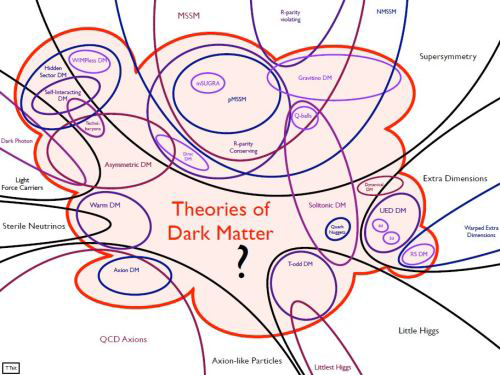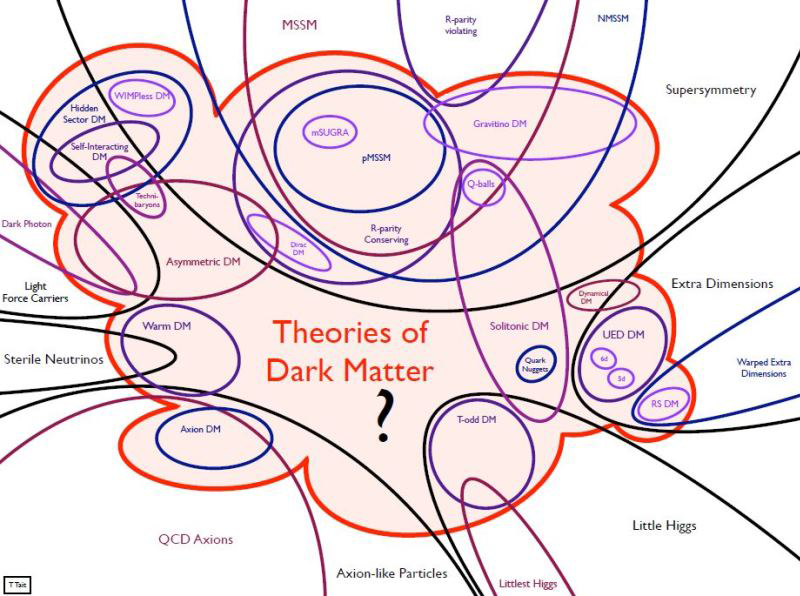Meetings: WIMP Alternatives Come Out of the Shadows
The Rencontres de Moriond (Moriond Conferences) have been a fixture of European high-energy physics for over half a century. These meetings—typically held at an Alpine ski resort—have been the site of many big announcements, such as the first public talk on the top quark discovery in 1995 and important Higgs updates in 2013. One day, perhaps, a dark matter detection will headline at Moriond. For now, physicists wait. But they’ve gotten a bit anxious, as their shoo-in candidate, the WIMP, has yet to make an appearance—despite several ongoing searches. At this year’s Moriond, held this past March in La Thuile, Italy, some of the limelight passed to other dark matter candidates, such as axions, black holes, superfluids, and more.
WIMPs, or weakly interacting massive particles, have been a popular topic over the years at Moriond, according to meeting organizer Jacques Dumarchez from the Laboratory of Nuclear Physics and High Energy (LPNHE) in France. The reason for this enthusiasm is that WIMPs fall out of theory without much tweaking. Extensions of the standard model, like supersymmetry, predict a host of particles with weak interactions and a mass in the 1 to 100GeV∕c2 range. If WIMPs like this were created in the big bang, then, according to simple thermodynamic arguments, their density would match the expectations for dark matter based on astronomical observations. This seemingly effortless matching has been called the WIMP miracle.
But these days, the miracle has less of a halo around it. At this year’s Moriond, updates from direct and indirect searches for WIMPs sounded almost apologetic. Alessandro Manfredini of the Weizmann Institute of Science in Israel told his listeners to “keep calm… and fingers crossed,” as he gave the latest news from Xenon 1T, a one-ton dark matter detector at Italy’s Gran Sasso laboratory. He showed that the experiment has now reached record-breaking sensitivity, so that if a 50GeV∕c2 WIMP exists, the next data release could reveal ten events. But, like other WIMP searches, the current results rule the particles out—by putting tighter limits on their properties—rather than rule them in. The hunt will continue for years to come, but the WIMP paradigm has “started to look less as the obvious solution to the dark matter problem,” Dumarchez said.
When did WIMP confidence start to deflate? Tim Tait from the University of California, Irvine, described the change as gradual. “It is hard to say exactly when it began, but I think it was becoming noticeable around 2014 or so,” Tait said. That’s when the null results from dark matter searches began closing the favored parameter space for the WIMP model. “Of course, there is still a good opportunity for those searches to discover WIMPs,” he said.
At Moriond, Tait gave an overview of dark matter candidates, in which he discussed WIMPs but devoted much of his time to the dazzling variety of other dark matter theories. Chief among these is the axion. Like the WIMP, it is well-motivated from particle physics theory, as it may explain why strong interactions do not violate CP symmetry, while weak interactions do. The axion is also the target of several dedicated searches, such as ADMX. Other familiar “dark horse” candidates discussed at Moriond were neutrinos and black holes—with the latter seeing a boost in popularity after recent gravitational-wave observations.
But at the conference, the doors seemed open to all comers, with several new dark matter ideas taking the stage. One of the talks was by Justin Khoury from the University of Pennsylvania in Philadelphia, who advocates a superfluid model of dark matter. The main assumption here is that dark matter has strong self-interactions that cause it to cool and condense in the centers of galaxies. The resulting superfluid could help explain certain anomalies in observed galactic velocity profiles.
Martin Sloth from the University of Southern Denmark takes a very different approach. Rather than having strong interactions, his so-called Planckian interacting dark matter has zero interactions beyond gravity, but it makes up for its lack of interactions with an enormous mass (around 1028eV∕c2). At the opposite end of the mass spectrum is fuzzy dark matter, weighing in at 10−22eV∕c2. These ethereal particles could explain an apparent lack of small galaxies. But they could also run into constraints from observed absorption in the intergalactic medium, explained Eric Armengaud from France’s Atomic Energy Commission (CEA) in Saclay.
Although WIMPs continue to be the odds-on favorite, the field has certainly expanded—with light and heavy masses, weak and strong interactions, and seemingly everything in between. Sloth compared the current situation without a WIMP detection to a Wimbledon tournament without Roger Federer: “Everybody is signing up, thinking that they now have a chance.”
But can theorists make compelling arguments for these alternatives, as they did for WIMPs? David Kaplan from Johns Hopkins University, Maryland, believes that theoretical backing will not be a problem. In fact, he commented that the community has been too fixated on WIMPs (and the miracle) for the last 30 years. He warned his compatriots to not make the same mistake again: “I don’t want the next 30 years to be just axions.”
–Michael Schirber
Michael Schirber is a Corresponding Editor for Physics based in Lyon, France.





